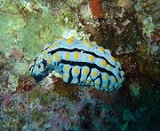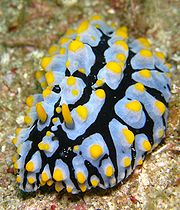
Phyllidia varicosa
Encyclopedia

Species
In biology, a species is one of the basic units of biological classification and a taxonomic rank. A species is often defined as a group of organisms capable of interbreeding and producing fertile offspring. While in many cases this definition is adequate, more precise or differing measures are...
of sea slug
Slug
Slug is a common name that is normally applied to any gastropod mollusc that lacks a shell, has a very reduced shell, or has a small internal shell...
, a dorid nudibranch
Nudibranch
A nudibranch is a member of what is now a taxonomic clade, and what was previously a suborder, of soft-bodied, marine gastropod mollusks which shed their shell after their larval stage. They are noted for their often extraordinary colors and striking forms...
, a shell-less marine
Marine (ocean)
Marine is an umbrella term. As an adjective it is usually applicable to things relating to the sea or ocean, such as marine biology, marine ecology and marine geology...
gastropod mollusk in the family Phyllidiidae
Phyllidiidae
Phyllidiidae is a family of sea slugs, dorid nudibranchs, marine gastropod mollusks in the superfamily Phyllidioidea.This family is within the clade Euctenidiacea .-Distribution:...
.
Distribution
This species is widely distributed throughout the Indo-West Pacific OceanPacific Ocean
The Pacific Ocean is the largest of the Earth's oceanic divisions. It extends from the Arctic in the north to the Southern Ocean in the south, bounded by Asia and Australia in the west, and the Americas in the east.At 165.2 million square kilometres in area, this largest division of the World...
s including the central Pacific and the Red Sea
Red Sea
The Red Sea is a seawater inlet of the Indian Ocean, lying between Africa and Asia. The connection to the ocean is in the south through the Bab el Mandeb strait and the Gulf of Aden. In the north, there is the Sinai Peninsula, the Gulf of Aqaba, and the Gulf of Suez...
.
Description
This is a large species that can be distinguished by its numerous (3 to 6), longitudinal, tuberculate notal ridges. The ridge and bases of the tubercles are a blue-grey colour. The tubercles are capped in yellow. The foot sole has a black longitudinal foot stripe. The rhinophoral clavus possesses 27 to 30 lamellae.Further reading
- Brunckhorst, D.J. (1993) The systematics and phylogeny of Phyllidiid Nudibranchs (Doridoidea). Records of the Australian Museum, Supplement 16: 1-107.
External links
- Phyllidia varicosa Lamarck, 1801 on philippine-sea-slugs.com

